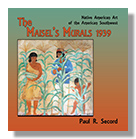 THE MAISEL'S MURALS, 1939
THE MAISEL'S MURALS, 1939
Native American Art of the American Southwest
By Order from Your INDEPENDENT BOOKSELLER
Booksellers Order from INGRAM CONTENT GROUP
Also PURCHASE BOOK & eBOOK ON AMAZON
The murals fronting the entrance of Skip Maisel’s Indian Jewelry and Crafts store at 510 Central Avenue SW in Albuquerque, New Mexico are a treasure of Native American painting and are of national importance. They represent some of the earliest and finest paintings by a seminal group of Southwestern native artists. Commissioned in 1939 by the store’s founder, Maurice Maisel, the grandfather of the current owner, the murals are an extraordinary expression of fine arts, rarely seen on a commercial building. Despite their prominence on the building’s façade, a fixture in downtown Albuquerque, they are essentially hidden in plain sight.
The murals’ subject matter demonstrates a unifying thematic context. Through the use of paired opposites, cultural themes and subjects can be compared and contrasted. In addition, the stylistic differences between artists, while showing the strong influence of training at “The Studio” art program at the Santa Fe Indian School established by Dorothy Dunn, they also demonstrate considerable differences in execution.
The Maisel’s building was designed by legendary New Mexico architect John Gaw Meem, popularizer of the Santa Fe Style. Meem hired well known Santa Fe artist Olive Rush for a total of $1,500 to paint the murals. She then hired eleven Native Americans to undertake the project and saw to it that they were paid a fair wage.
Maisel’s was to be Rush’s last Native American project and she clearly wished the project to be a culmination statement of the mural work she had been engaged in with The Studio for nearly a decade. To that end, she included artists of varying ages, from forty-four year old Awa Tsireh of the first generation of Pueblo painters, to sixteen year old Popovi Da, a beginning Studio painter and the son of famous potters Maria and Julian Martinez, as well as including representatives of three principal Native American cultures in the Southwest: Pueblo, Navajo and Apache.
Paul R. Secord is a 1972 graduate of the University of New Mexico with degrees in anthropology and geology. He had a professional career in Southern California as a planning consultant specializing in historic and cultural resources. Since moving permanently to New Mexico in 2010, he has undertaken a number of history and archaeology projects and is the author of five books on New Mexico history: Albuquerque Deco and Pueblo, Santa Fe’s Historic Hotels, Pecos, Bandelier National Monument, and The Galisteo Basin and Cerrillos Hills.
Hardcover:
8 1/2 x 8 1/2 Illustrated, Color
ISBN: 978-1-63293-698-1
78 pp.,$39.95
Softcover:
8 1/2 x 8 1/2 Illustrated, Color
ISBN: 978-1-63293-224-2
78 pp.,$19.95